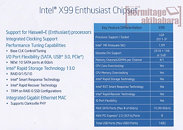- Joined
- Oct 9, 2007
- Messages
- 47,300 (7.52/day)
- Location
- Hyderabad, India
| System Name | RBMK-1000 |
|---|---|
| Processor | AMD Ryzen 7 5700G |
| Motherboard | ASUS ROG Strix B450-E Gaming |
| Cooling | DeepCool Gammax L240 V2 |
| Memory | 2x 8GB G.Skill Sniper X |
| Video Card(s) | Palit GeForce RTX 2080 SUPER GameRock |
| Storage | Western Digital Black NVMe 512GB |
| Display(s) | BenQ 1440p 60 Hz 27-inch |
| Case | Corsair Carbide 100R |
| Audio Device(s) | ASUS SupremeFX S1220A |
| Power Supply | Cooler Master MWE Gold 650W |
| Mouse | ASUS ROG Strix Impact |
| Keyboard | Gamdias Hermes E2 |
| Software | Windows 11 Pro |
Here's what the first wave of Intel 9-series chipsets will look like. It will consist of upper-mainstream chipsets for the LGA1150 platform, and the sole chipset for the LGA2011-3 HEDT platform. LGA1150 will get two new chipsets based on a common silicon, the Z97 Express, and the H97 Express. The Z97 will be the next top-end chipset for the platform, supporting current Core "Haswell" and upcoming "Haswell refresh" and "Devil's Canyon" processors. Motherboards based on the Z97 chipset, like the ones based on the Z87 and Z77, will feature up to three PCI-Express 3.0 slots wired to the CPU, in configurations of x16/NC/NC, x8/x8/NC, and x8/x4/x4. It will support overclocking, something its sibling the H97 Express will lack. The H97 will also lack the PCIe configurations that the Z97 supports.
Both Z97 and H97 will introduce support for PCI-Express M.2 storage, which offers 66.6% higher bandwidth than SATA 6 Gb/s, and the same bandwidth as SATA-Express. Its introduction will spur up development and launches of a new generation of high-performance client SSDs in 2014-15. Apart from M.2, the two chipsets offer six SATA 6 Gb/s ports with AHCI and RAID support. Rapid Storage Technology (RST) and Smart Response Technology (SRT) are common for both chips, however, the Z97 also features Dynamic Storage Accelerator (DST), something the H97 will lack. H97 will exclusively offer Small Business Advantage (SBA), instead. Both chips will feature 8-lane PCI-Express gen 2.0 root complexes to drive onboard devices, and 14 USB ports, including six USB 3.0 SuperSpeed ports.


The X99 Express is a different beast altogether. Designed for the upcoming "Haswell-E" HEDT platform, and the next-generation LGA2011-3 socket (incompatible with current LGA2011), the X99 platform is designed for high-end multi-GPU builds. It will let motherboard designers build boards with up to five PCI-Express 3.0 x16 slots wired to the CPU, in either x16/NC/x16/NC/x8, or x16/NC/x8/x8/x8, or even x8/x8/x8/x8/x8. Letting you toss in a screamingly fast PCIe SSD along with your 4-way multi-GPU setup. Intel appears to have gotten over the SATA+SAS mess it built with the previous X79/C608 common silicon, and gave the X99 a monolithic 10-port SATA 6 Gb/s storage controller, with RST and SRT support. SSD TRIM will be supported on RAID 0 configurations. An 8-lane PCI-Express gen 2.0 root complex drives onboard devices, just like the on the Z97/H97, and a 14-port USB controller, with 6 USB 3.0 ports completes its main feature-set. Intel plans to launch the three around Q2-Q3, 2014.
View at TechPowerUp Main Site
Both Z97 and H97 will introduce support for PCI-Express M.2 storage, which offers 66.6% higher bandwidth than SATA 6 Gb/s, and the same bandwidth as SATA-Express. Its introduction will spur up development and launches of a new generation of high-performance client SSDs in 2014-15. Apart from M.2, the two chipsets offer six SATA 6 Gb/s ports with AHCI and RAID support. Rapid Storage Technology (RST) and Smart Response Technology (SRT) are common for both chips, however, the Z97 also features Dynamic Storage Accelerator (DST), something the H97 will lack. H97 will exclusively offer Small Business Advantage (SBA), instead. Both chips will feature 8-lane PCI-Express gen 2.0 root complexes to drive onboard devices, and 14 USB ports, including six USB 3.0 SuperSpeed ports.


The X99 Express is a different beast altogether. Designed for the upcoming "Haswell-E" HEDT platform, and the next-generation LGA2011-3 socket (incompatible with current LGA2011), the X99 platform is designed for high-end multi-GPU builds. It will let motherboard designers build boards with up to five PCI-Express 3.0 x16 slots wired to the CPU, in either x16/NC/x16/NC/x8, or x16/NC/x8/x8/x8, or even x8/x8/x8/x8/x8. Letting you toss in a screamingly fast PCIe SSD along with your 4-way multi-GPU setup. Intel appears to have gotten over the SATA+SAS mess it built with the previous X79/C608 common silicon, and gave the X99 a monolithic 10-port SATA 6 Gb/s storage controller, with RST and SRT support. SSD TRIM will be supported on RAID 0 configurations. An 8-lane PCI-Express gen 2.0 root complex drives onboard devices, just like the on the Z97/H97, and a 14-port USB controller, with 6 USB 3.0 ports completes its main feature-set. Intel plans to launch the three around Q2-Q3, 2014.
View at TechPowerUp Main Site








 DDR4 platform will be new and like every first thing, there are everytime problems.
DDR4 platform will be new and like every first thing, there are everytime problems.